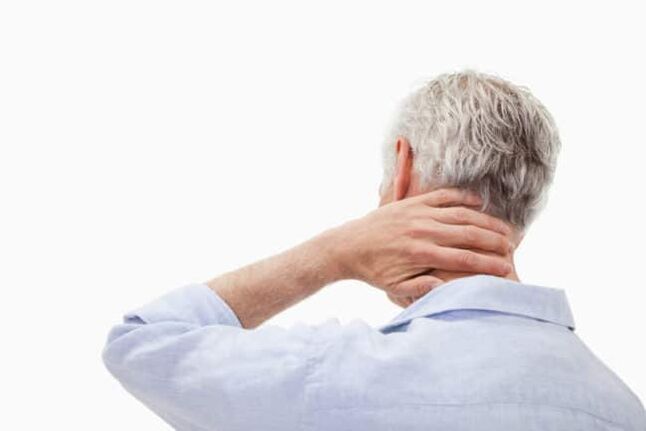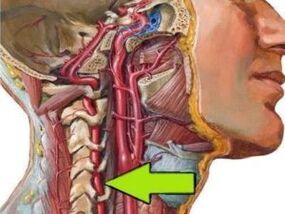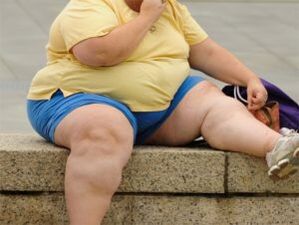Among all the pathological processes that affect the various parts of the spine, cervical osteochondrosis is considered one of the most common and painful.This disease causes many complications, mainly because it affects the spinal cord and also adversely affects the functioning of the brain.

What is cervical osteochondrosis?
The words of cervical osteochondrosis in medical practice mean a progressive disease that affects the specific spine.This pathological process is characterized by degenerative-dystrophic processes in the tissues of intervertebral discs that are shocking to the cervical spine.Degenerative-dystrophic changes in the intervertebral discs are due to the fact that they are erased and deformed.As a result, the distance between the vertebrates decreases and the following results are resulted in:
- Narrow the spinal canal in certain areas of the spine.
- Passing of the spine arteries - Large blood vessels that provide blood to the brain.Because of this, the supply of the brain will deteriorate and the cervical circulation of the cervical spinal cord is impaired.
- Intervertebral discs can be deformed and flattened.This causes weakening of individual sections of the spinal cord and nerves, more often, the nerve roots contract.
All of these problems threaten not only the blood flow to the brain, the painful sensations of the neck, headaches, etc.The development of osteochondrosis of the cervical region is dangerous with neurological nature problems, deterioration of the central nervous system, brain tissue damage.According to the International Classification of Diseases, several separate codes were entrusted with osteochondrosis of the cervical region.Disease Code for ICB 10 depends on the age of the disease: the disease was observed:

- M02 - Dystrophy of intervertebral discs in adolescence.
- M42.12 is a dystrophic process in the neck in adults.
Many factors depend on the patient's age and the quality of the pathological process, such as results, complications, symptoms and, of course, the principles of treatment.
Causes
Knowledge of the causes of osteochondrosis in the cervical region can play a key role in the diagnosis, as well as to establish the principles of combating the disease.However, before listing the reasons, it is worth saying that doctors distinguish two factors that lead to the development of this abnormal process:
- Abnormal - Destruction of intervertebral discs and other vertebrates with the involvement of nearby tissues, blood vessels and nerve beams in the pathological process, under the influence of negative external factors.The more difficult these factors and other pathologies, the faster the disease develops.
- Physiological - based on the development of pathology, mainly age -related changes.We are talking about the natural aging of cartilage tissues in the spinal column, salts, etc.
If we list the more specific causes of cervical osteochondrosis, they are as follows:
- Disruption of metabolic processes in the body, as well as certain stages of obesity.
- Hypodynamia is a phenomenon that is characterized by limitation of mobility.It is not only about injuries or diseases, it can also contain a sedentary lifestyle and a meeting work.
- Pathologies of the cardiovascular system, which contribute to lowering blood circulation in the brain, pressure changes and other items.
- Wrong posture, this is a different form of scoliosis, rheumatism and even flat legs.
- Injection of the cervical spine.In this case, we are talking about spray, strikes, bruises.Other spine studies in the development of cervical osteochondrosis may affect the development of cervical osteochondrosis.
- Excessive physical effort in the cervical region caused by intense sports or severe physical complexity, it depends on the type of human activity.
- Tempting lifestyles are also dangerous for the constant tension of the cervical spine and the whole spine if you sit wrong or uncomfortable furniture.
- Cervical spine hernia, as well as various related diseases.
- Forced long -term conducting the head in an uncomfortable or unnatural state.In this case, not only the muscles are excessive, but the spine of the spine is also a curve in the cervical region.
- Doctors believe that constant stress and nervous overdose consider it a very common cause.
- One of the causes is also considered congenital anomalies in the spine structure.

What is the threat to health?
As already mentioned, the cervical spine is not only spinal cord and various nerve branches, but also spinal arteries that supply part of the brain, cerebral and medulous brain.With the development of cervical osteochondrosis, nearby tissues are illuminated.In addition, the development of pathology threatens the weakening of the nerve roots and the transmission of blood vessels, the results are as follows:
- Osteochondrosis is accompanied by deformities of the spine, resulting in the cerebrospinal channel narrowing in certain areas.This can lead to weakening of the spinal cord and nerve branches, which promises severe neurological problems.In severe cases, a person feels pain, even if there is a possibility of loss of control over certain parts of the body (mainly in the hands or face).
- The weakening of the neck vessels, as we have already mentioned, is accompanied by a disorder of blood flow to the gastrointestinal tract.At the same time, the brain ceases to receive oxygen and nutrients in the required amount of oxygen, and oxygen starvation begins.With circulatory disorders, there is a real risk of ischemic stroke and various neurological pathologies.
Syndromes
The main syndromes are:
- Spine.
- Spine artery.
- Koresca.
- Heart.
It is important to know that each of these symptoms is accompanied by painful sensations of different nature, as well as many unfavorable clinical signs.A person can feel dizzy, noise in his ears, and many more.

Spine syndrome
It talks about the direct connection of osteochondrosis of the cervical region with bone and cartilage tissues.Symptoms of this type of pathology are also associated with the tissue damage mentioned:
- Neck movements are partially or completely limited.
- The movements of the head are accompanied by pain in the neck.
- X -Ray shows morphological changes in tissues (intervertebral and spine).
It should be noted that spine syndrome is always accompanied by these three clinical signs.If there are at least 1 of them, the diagnosis will be completely different.
Rook
This occurs when the roots of the spinal cord are damaged.At the same time, neural conduction is impaired, a person can feel pain or lose sensitivity to certain parts of the body, or even to cause paralysis.Depending on which of the following 8 radical pairs is a conduction disorder, such symptoms are distinguished:
- 1 pair - bumps or pain in the back;
- 3 pairs - chewing reflex disorders, tongue irrigation and unpleasant sensations behind the ears;
- 4 pairs - pain in the clavicle, disruption of swallowing reflex;
- 5 pairs - a disruption of the shoulder girdle, accompanied by a hand movement problem;
- 6 pairs - The patient begins to feel pain and bumps of the forearm and shoulder blades;
- 7 pairs - hands and fingers are blown (often index and middle);
- 8 pairs - problems with the past thing, but numbness is felt on the finger and the little finger.
Cardial Syndrome
Although the abnormal process is still localized in the cervical spine, the syndrome has all signs of cardiac pathologies.The clinical picture is as follows:
- Fast pulse.
- Pain in the region of Sternum.
- Shortness, weakness, lethargy, decreased performance.
Signs and symptoms of cervical osteochondrosis
In search of a doctor's timely, you need to clearly understand the signs of cervical osteochondrosis.In some cases, such knowledge allows you to help at the initial stage of the disease when treatment is easier.In general, the symptoms of osteochondrosis of the cervical spine are as follows:

- For osteochondrosis, pain is always found, only intensity and frequency vary.This is the pain that is the first clinical sign.Their intensity depends on the stage of disease progression, in nature they are foolish or sink.Painful sensations are mainly found in the neck of the neck, but can also radiate to the temporal region, shoulder girdle and hands.
- In most cases, there are manifestations of damage to the vestibular apparatus.We are talking about frequent immature dizziness, nausea, impaired coordination of movements, uneven walking, losing space.
- One of the most common clinical signs is the strength of the neck muscles and the strength of the movements.It is difficult for a person to turn, down and down, movements respond to pain.
- Many patients point out the feeling that goosebumps "pass through the scalp" or characteristic quarrel.
- At the vicinity of the hands is muscle weakness and numbness.
- Often there are psychological manifestations that are expressed in depression, drowsiness, drastic change in mood, temperament or irritation.
- Due to blood flow to the bloodstream and brain tissue damage, dizziness is intense and noise in the ears, similar to rust, pulsation, bell.
- Most patients indicate visual failure, as well as pain in the eye cavity, especially when trying to get the eyes on the left, right, high or down.
Sometimes it is possible to determine the degree of development of the pathological process with symptoms.However, for a complete diagnosis, this is still not enough and many diagnostic measures are needed.
Diagnostic methods
Diagnosis of cervical spine osteochondrosis is essential for localization and stage of disease progression.For a complete diagnosis, such diagnostic methods are required:
- X -Ray - A basic method that allows you to determine the degree and localization of the deformation of the spinal column.
- You can use computed tomography for a more accurate diagnosis of abnormal changes in the vertebrates and intervertebral discs.
- MRI (Magnetoresonance Imaging) - allows in detail to study wheels and vertebrates, prescribe hernia, prostheses and the rest of the injury.
- Dopplerography - At the same time, the examination is the ability to find a place to weaken the artery, to evaluate the degree of circulatory disorders.
Methods of treatment
Treatment of osteochondrosis in the neck always involves an integrated approach.The principles of treatment depend on the weight of the factors such as the patient's age, the stage of disease development, the brightness of the clinical picture, etc., nevertheless, you cannot do without a doctor in this situation and, first, you can consult with a therapist who will then take you to a verticalologist.As for the integrated approach: Osteochondrosis of the cervical osteochondrosis is treated using drug therapy, physiotherapy, massages, exercise therapy and other methods that should be discussed in more detail.
Treating the drug
The basis for the treatment of cervical osteochondrosis is drug therapy, which involves the use of tablets, drugs and drugs in such groups:
- Anesthetics - Analgesics and Antispasmodics.The former directly boring nerve centers, thereby stopping painful sensations.The latter allows you to relieve neck muscle spasms, determine blood flow and crush pain.
- NSAIDS -Non -inflammatory agents are essential to reduce the inflammatory process, most of them also eliminating pain.Often these medications are used as gels, ointments that are cut into the affected side.
- Musorelaxants are another way to get rid of muscle spasm in the cervical region.
- Chondroprotectors are mandatory at a certain stage of osteochondrosis as they help restore bone tissue.
- B Vitamins - Normalize the metabolic processes of nerve tissues, improve nerve impulses and contribute to the functioning of the central nervous system.
Remember, treatment should only be performed under the supervision of a physician responsible for the administration of each medicine, as well as the duration of its administration and dosing.
Physiotherapy
Treatment of osteochondrosis in the neck will be many times more effective using some of the techniques of physiotherapy:

- Electrophoresis.
- Laser therapy.
- Ultrasound.
- Massage.
Massage therapy is necessarily performed by an experienced healthcare worker, treatment is performed at least 10 sessions.Massages of the cervical region help normalize blood circulation, restore elasticity, muscle tone, relieve pain, etc.
Manual therapy
Manual therapy is based on the principle of restoring motor functions between the vertebrates and restoring mobility.Initially, the manipulations are in a light rest massage, then the doctor gives more and more strength, acting on the vertebrates of the pressure and neck alternatives.
The use of Kuznetsov applicators is one of the methods of spine disease therapy, including osteochondrosis.The effect of adaptation in the cervical region normalizes metabolic processes, soothes pain, increases muscle tone, improves blood circulation, increases nerve tissue permeability, etc.


























































































